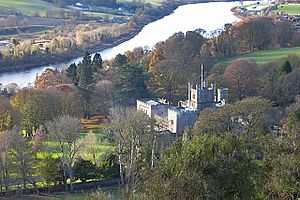Kinfauns Castle facts for kids
Quick facts for kids Kinfauns Castle |
|
|---|---|
 |
|
| Location | Near Perth, Scotland |
| Built | 1825 |
| Built for | Lord Gray |
| Architect | Robert Smirke |
| Architectural style(s) | Castellated |
|
Listed Building – Category A
|
|
| Designated | 5 October 1971 |
| Reference no. | LB11955 |
|
Inventory of Gardens and Designed Landscapes in Scotland
|
|
| Designated | 1 July 1987 |
| Reference no. | GDL00240 |
| Lua error in Module:Location_map at line 420: attempt to index field 'wikibase' (a nil value). | |
Kinfauns Castle is a beautiful castle built in the 1800s. It's located near Perth in Perth and Kinross, Scotland. The castle looks like an old fortress but has a touch of Georgian style. It sits on a high spot, looking out over the River Tay. Kinfauns Castle is so important that it's protected as a special historic building. Its gardens are also recognized as important landscapes in Scotland.
Contents
The Story of Kinfauns Castle
The history of Kinfauns Castle goes back a very long time. It starts with a brave knight named Thomas de Longeville.
Early Days and First Castle
In 1313, Thomas de Longeville fought alongside William Wallace and helped capture Perth. As a reward, Robert the Bruce, the King of Scotland, gave him land east of Perth. Thomas later married a woman from the Charteris family of Kinfauns. He then changed his name to Charteris and built the first Kinfauns Castle on this land.
Family Feuds and Changes
The Charteris family had a long-standing disagreement with another powerful family, the Ruthvens of Perth. Sadly, in 1552, John Charteris was killed by the Ruthvens in Edinburgh. After this, the castle and land were passed to different families, first the Carnegies, and then the Blairs.
Building the Modern Castle
In 1741, the Kinfauns estate became part of the Gray family. This happened when a Blair family member married the 11th Lord Gray. The castle you see today was designed by a famous architect, Sir Robert Smirke. It was built between 1822 and 1826 by Francis Gray, 14th Lord Gray. This new castle was built right where the old medieval fortress used to stand.
Later Owners and Improvements
In 1878, the castle was passed to the Stuart Earls of Moray. The 17th Earl of Moray made some important improvements to the estate. For example, a walled garden and a gardener's cottage were added in 1910. After the 17th Earl passed away in 1930, much of the land was sold off.
Kinfauns Castle Today
Today, Kinfauns Castle and the remaining land are owned by a Scottish businesswoman named Ann Gloag. She is well-known for co-founding the Stagecoach company.
The Railway and Kinfauns
In the 1840s, a new railway line was being built between Dundee and Perth. This railway needed to pass through the Kinfauns estate.
Lord Gray's Condition
The owner at the time, Lord Gray, agreed to let the railway come through his land. However, he asked for a large sum of money for it. He was paid £12,000, which was a very big amount back in 1847!
Images for kids


